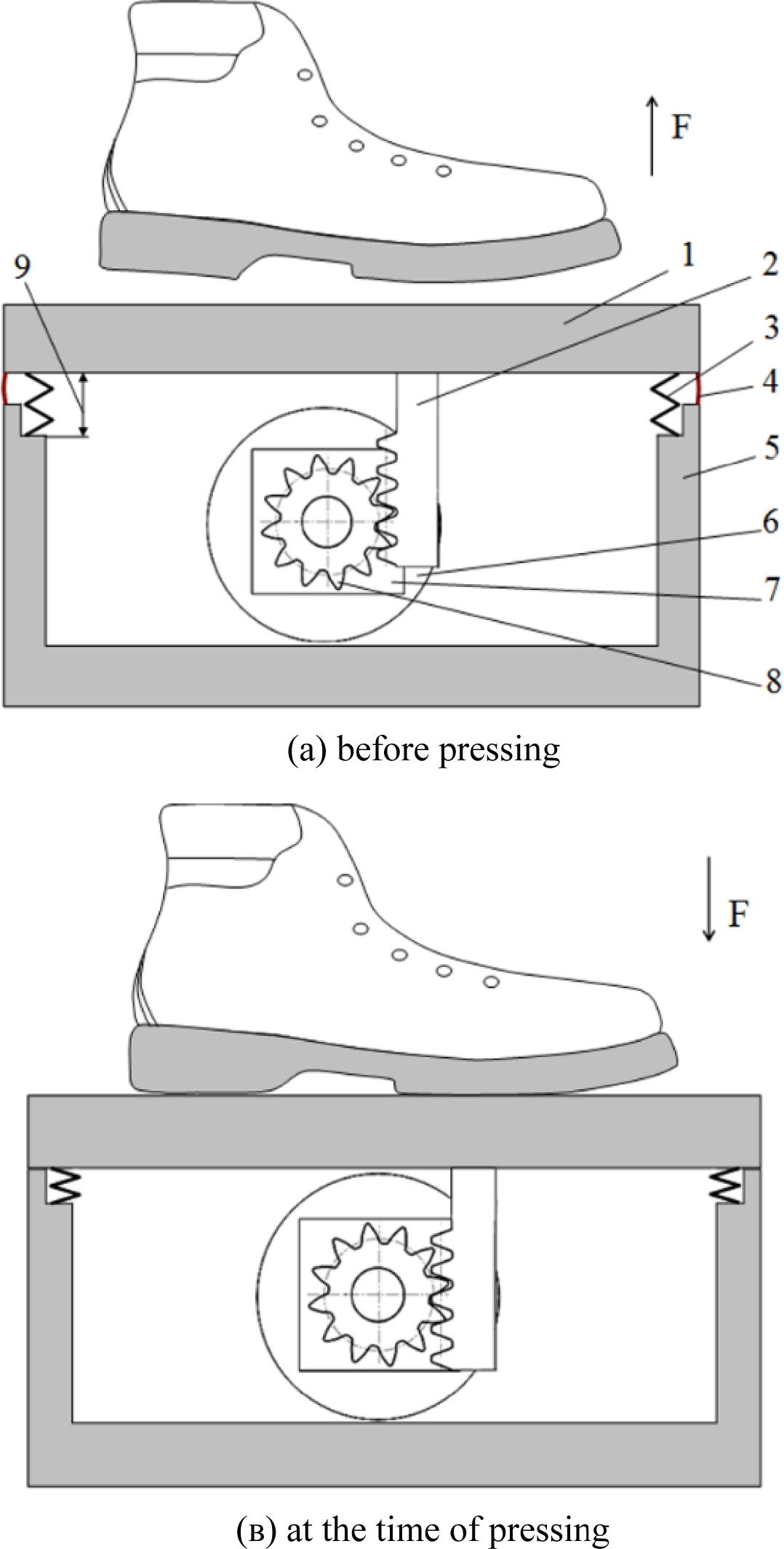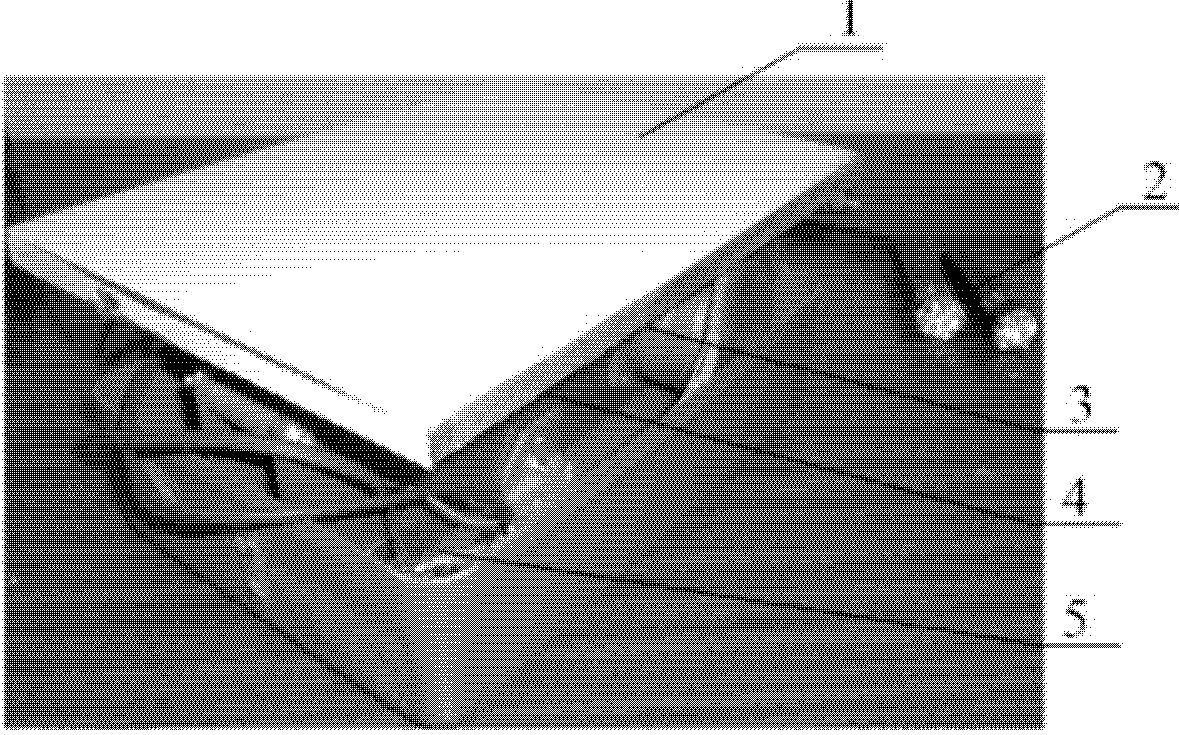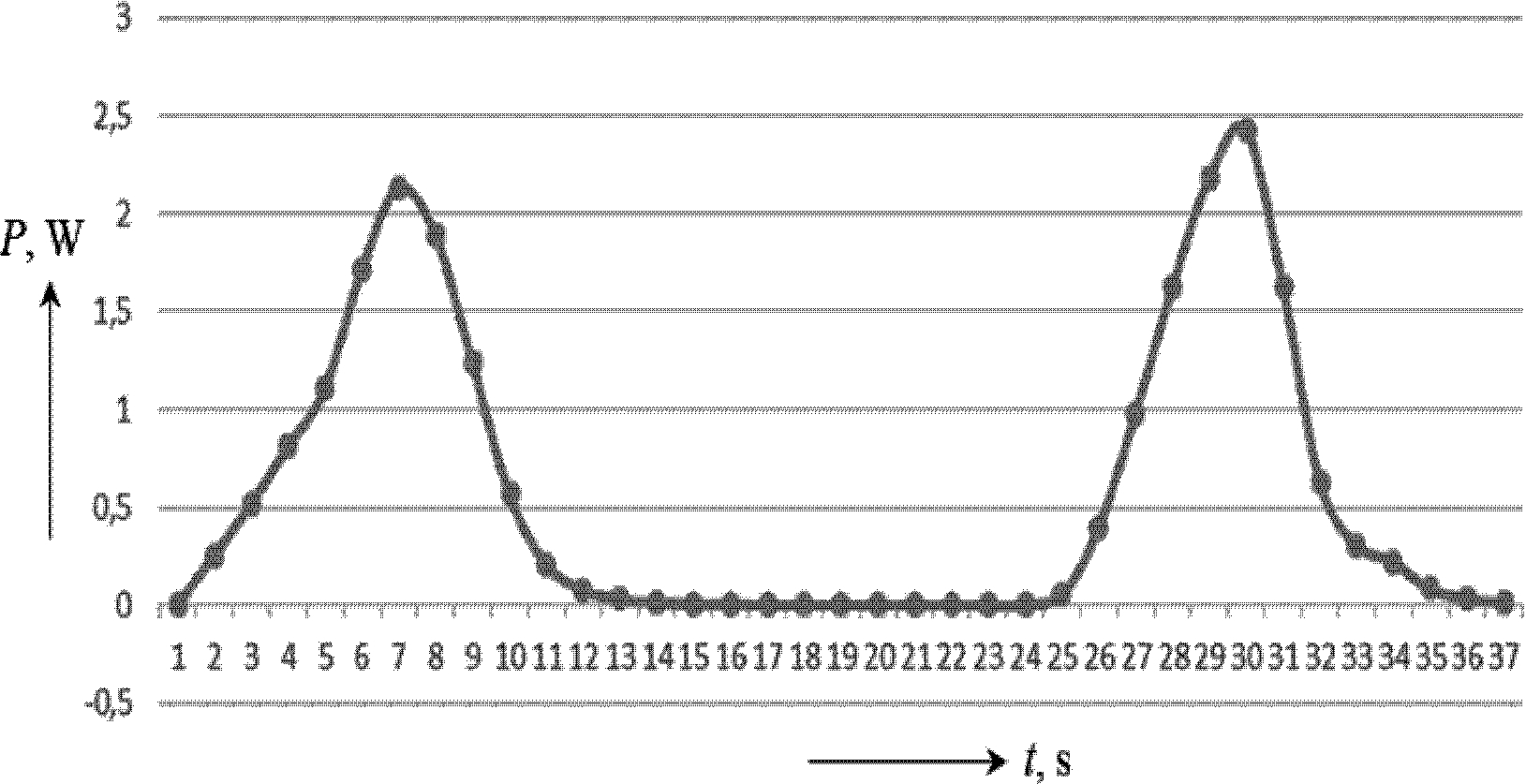
A Device for Converting Kinetic Energy of Press Into Electric Power as a Means of Energy Saving
Copyright © The Korean Society for Precision Engineering
This is an Open-Access article distributed under the terms of the Creative Commons Attribution Non-Commercial License (http://creativecommons.org/licenses/by-nc/3.0) which permits unrestricted non-commercial use, distribution, and reproduction in any medium, provided the original work is properly cited.
Abstract
The analysis of existing alternative power source equipment that convert other types of energy into electric power was carried out. This study proposed a technical solution for the design of the power generating tile or step, which converts the kinetic energy of press into electric power and accumulates it. The operating principle of the power-generating tile is described as an alternative, decentralized source of electrical energy. The experimental research of the developed device was conducted and the method of conversion of kinetic energy into electric power improved. A correlation method that allows conducting analysis and calculation by quantitative indicators of the generated electricity from press was presented. The proposed device can be used as an alternative source of electricity in places with great foot traffic. The device has small overall dimensions and can easily be set up in various types of aisles, stairs, and integrated into the network of LED lighting.
Keywords:
Energy-generating tile, Alternative energy Source, Energy-saving technologies1. Introduction
Currently, the issues of energy saving and energy efficiency are becoming increasingly topical, and, therefore, methods for their implementation and the means that directly make such implementation possible are much needed.1 In this area, a fairly large number of different types of research is being made.2-5 The most urgent of these is the development and research of tools and instruments that can reduce dependence on centralized power sources or reduce the expenses for electricity.6-8
This paper presents the studies devoted to solving the problem of energy saving and energy efficiency in institutions, buildings and places with a great foot traffic. The main idea of the work is to develop and implement a low-duty device for generating electricity. The idea is based on the methods and means of converting kinetic energy into electric power, which will generate the required amount of electricity and also provide the power supply system with additional, alternative low-duty power sources. The introduction of the device under research, which is patented by the authors of the work,9,10 will allow saving energy, its efficient allocation and balancing according to the power.
The purpose of the work is to study a low-duty electric power source that converts kinetic energy into electric power as a means of energy saving and increasing energy efficiency.
The Pavegen tile, developed by Laurence Kemball-Cook's, a researcher from England, is an analogue of the proposed device.11,12 This tile converts kinetic energy from steps into electric power. The principle of such a tile is based on the piezoelectric effect, which greatly affects its price and reliability.
Russian scientists Kh. Abramovich, E. Kharash and others have proposed a similar development.13 Their device is a part of the system and methods of collecting energy on roads and highways using a piezoelectric generator. The disadvantage is that it needs a stationary structure and appropriate assemblage.
In the article written by Xiaofeng Li, V. Strezov14 and in the article written by A. Shukla, S.A. Ansari15 the possibility of using a piezoelectric tile in an educational institution is considered.
In the United States, the inventors S. Brusaw, J. Brusaw proposed a device “Solar Roadway Panel”, which converts the sun energy into electricity. The generated electricity is used for the own needs of the device and for the power supply of the newest “Intelligent Road” systems.16 It should be noted that this development requires complete re-equipment of both the road and its entire infrastructure. Also, this development cannot convert kinetic energy of press into electric power. In the work by V.R. Skoy17 the “Piezoelectric DC generator based on the Casimir effect” is described. The invention belongs to energy converters operating on the basis of the use of piezoceramic materials. As for the drawbacks of such devices, as has already been noted, one can mention their low reliability, which is explained by the use of piezoceramics. In his article Shalabh Bhatnagar4 considers the fundamental possibility of obtaining electric energy by converting it from the energy of sound waves and using piezoelectric elements. But the author considers only the fundamental possibility of such conversion and does not provide concrete technical solutions for it. Xinyu Xue, Sihong Wang18 proposed to combine the process of conversion of mechanical energy into electrical power with the process of electric energy accumulation in the form of chemical energy. But, as in the previous case, the authors do not indicate the operational and technical characteristics of their development. In19 Salvatore Cafiso and M. Cuomo provide substantiation for using piezoelectric transducers on asphalt pavement in terms of efficiency and power generation. Thus, there are many examples of possible conversion of kinetic energy from press into electric power, but no specific technical solutions are given for practical implementation of this process. It should also be noted that such devices are designed for significant pressing force and can only be installed on motorways.
The given analysis of the reviewed papers on the development and research of various systems and devices that convert various types of energy into electric power indicates that this problem is topical and urgent for the general public.
2. The Design of the Device
To date, an electromechanical device for transformation of kinetic energy into electric power, where the kinetic energy from people’s steps is transformed into electric power and accumulates in capacitive storage devices - ultracapacitors and accumulator batteries, looks promising and effective.20 In this case, energy conversion occurs due to the use of an electric machine, where the energy of press is converted into rotational energy of the electric machine rotor. Such a device can be used as an alternative and decentralized low-duty power source.
The electromechanical device of converting kinetic energy into electric power with an electric generator is suggested. The device has a housing with a pressure plate, where the rotor and the stator are co-located and can move relative one another. In this case, the similar ends of the stator windings are connected to each other and go to an electric rectifier, whose output clamps are connected to a capacitive storage - an ultracapacitor. The ultracapacitor, through the diode, recharges the accumulator battery, which is connected to the load via the switch (Figs. 1 and 2).

The design of the device: 1 - the pressure plate; 2 - the electric generator drive rail; 3 - the spring; 4 - the airtight connection of the plate with the housing; 5 - the body; 6 - the electric machine (electric drive); 7 - multiplier; 8 - the electric generator drive gear; 9 - the pressure plate working stroke; F - the pressing force

The device principal electrical scheme: 1 - the pressure plate; 6 - the electric machine (electric generator); 7 - the multiplier; 10 - the electric rectifier; C - the capacitive storage; VD - the diode; GB - the rechargeable battery; S - the switch; Z - the load
The rotor of the electric generator rotates about the axis under the action of the electric generator drive rail through a cylindrical multiplier, which increases the angular velocity of rotation.
The feature of the proposed device for converting kinetic energy into electric power is its small dimensions and weights and the fact that can be easily installed in places with a large number of pedestrians and the great density of human flow. At this, the process of conversion of kinetic energy into electric power is more effective than in case with the devices mentioned above.
3. Principle of Action
The principle of operation of the proposed device is explained by schematic drawings, Figs. 1 and 2, patented by the authors of the work.10
When pressing on the electromechanical device of converting kinetic energy into electric power with a multiplier, its press plate 1, connected by a hermetic coupling of the plate to the housing 4, starts moving downward under the action of the pressing force F (Fig. 1), thereby moving the generator drive rail 2, which is tied to the pinion gear of the electric generator 8. The drive rail of the electric generator 2 moves downward for the entire pressure plate working stroke 9, until the pressure plate 1 lies on the housing 5 and thereby turns the electric generator 8 which is firmly attached to the shaft of the electric machine rotor 6 and the multiplier 7, which increases the angular rotational speed of the electric machine rotor 6. The electric generator rotor, rotating about its axis, directs the electromotive force in the windings of the electric machine stator 6. When removing the foot from the electromechanical device of converting the kinetic energy in the electric power, the springs 3 turn the pressure plate 1 to its original position, and the electric generator rotor, under the action of the electric generator drive rail 2 through the electric generator drive gear 8 begins to rotate in the opposite direction and directs the EMF in the stator windings with a negative value. The electric generator stator windings are connected to the electric rectifier 10 (Fig. 2). When the EMF is directed, an alternating electric current starts to flow by the windings, and after it is rectified on an electric rectifier 10, it charges the capacitive storage C-ultracapacitor and via the VD diode - a storage battery GB. The switch S switches the power supply to load Z.
Thus, the proposed electromechanical device for converting kinetic energy into electric one makes possible to increase the efficiency of converting energy of pressing into electric power by using an electromechanical energy converter based on an electric machine. In this case, the overall dimensions of the device remain the same as described in.11,13
4. Experimental Research
In order to confirm the efficiency of the proposed device of converting kinetic energy of pressing into electric power an experimental sample of one element of this device was developed. The device itself can have several such elements. On the basis of this sample, a series of experimental studies have been carried out on conversion of kinetic energy of pressing into electric power, its accumulation and subsequent use. The photo of the developed element of the experimental sample is shown in Fig. 3.

The element of the experimental sample of the device for converting kinetic energy of press into electric power: 1 - the pressure plate; 2 - the external load (LED lamps); 3 - the electric machine (electric generator); 4 - the multiplier; 5 - the electric rectifier
- Technical characteristics of the developed prototype:
- · Number of electric generators - 2 pcs (DS-200-1);
- · Multiplier (gearbox) with a gear ratio of 1: 2;
- · The working stroke of the pressure plate - 10 mm;
- · Load - 2 lamps from the 9 LED lantern, 60 lumens (or Li-ion accumulator batteries - for the charge);
- · 2 Li-ion accumulator batteries: ICR 18650 (2200 mAh; 3,7 V);
- · Geometric dimensions: height – 150 mm; width – 200 mm; length – 250 mm.
The purpose and conditions of the experiment. The goal of the work is experimental research of the device transforming kinetic energy into electric one and determination of energy characteristics and potential of the given device when using it as an alternative renewable source of energy.
Depending on the available conditions, needs and technical capabilities, the device of converting kinetic energy into electric power can consist of several elements (Fig. 3). So, to determine, the power value from one press the measurements were taken on one electric generator. This is due to the fact that both electrogenerators of the pilot sample have the same output and operate in identical conditions. Therefore, in order to get rid of various kinds of errors, measurements are made on one electric generator, and then these values are multiplied by the number of electric machines available in the device (in this case, by “2”).
A series of measurements of 100 presses are carried out and the graphs of dependence of the generated capacity on time are built. Then the integration of the received graphs is carried out and the quantitative value of the generated power is determined.
Experimental studies are presented on Fig. 4. in the form of the graph showing the dependence of generated power on time when pressing the device (Fig. 3).

The graph of measurement of the generated power resulted from two presses on the device (sampling rate is 100 Hz)
One pressure generates two impulses of electricity, due to the fact that during the reverse stroke of the pressure plate the electric generator rotates in the opposite direction, which also results in generation of electricity. The top value of generated voltage per one step is 5 V, the rotor rotation frequency being up to 360 rpm.
Integration of the received graphs (Fig. 4) made it possible to determine that 100 presses (corresponding to 100 steps), generated 16.89 W/h. Thus, an element of the device for converting kinetic energy of press into electric power with two electric generators generates 33.78 W/h with 100 steps performed on it. If the power generating tile or step consists of 2 such elements, then it will generate 67.56 W/h, and, if it consists of 4, then it will generate 135.12W/h. The number of items in one such device is determined by the technical conditions of its installation and location. Assuming that the average number of presses per step in front of an educational institution (secondary school, technical school, university, etc.) is approximately 10,000 per day (this Fig. depends on the number of people working and studying at a particular institution), then we determine that one such device with 2 elements will generate 6.76 kWh, and a device with 4 elements will generate 13.5 kWh. The calculations carried out are summarized in Table 1.
5. Discussions
Analyzing the results obtained (Table 1) one can conclude that one such device installed at the entrance to any educational institution (entrance to the building or the territory of the institution, various types of passages, stairs, etc.) will be sufficient to meet the requirements for electric lighting (using LED technology) during a dark day. If several devices are installed, then it is possible to partially or completely abandon the centralized illumination of the territory or premises (in educational institutions) that are intended for general use, such as corridor, halls, lobbies, etc. This will result in reduction of expenses for electrical supply and in saving money for consumed electricity.
The presented design, the circuit decision and the described principle of the device operation helps to evaluate the simplicity and efficiency of the proposed converter.
The paper presents the results of the experimental studies of the proposed device. The analysis of the obtained results has shown that the 4-element device is capable of generating 13.5 kWh of power during 10 thousand presses.
It should be noted that the presented development requires further improvement for wide-range use and can then be used both inside the buildings and outside in the places with big traffic of moving objects.
The pressure plate can be returned to its place (put up) by the step engine, working as an electric motor (in the engine mode). The changes should be made in the design of the device and the software for the step engine must be provided for. The algorithm of work of the electric device unit when raising the pressure plate should be suggested, and the corresponding electronics (electronic plates) that will realize this algorithm. We should take into consideration that when raising the pressure plate the electric current is necessary, which will be supplied by Li-ion accumulator batteries. It can decrease the value of the generated energy by the value necessary for the step engines work. This kind of research will be made and presented in future works. But we must underline that when a step engine works as an electric motor, only one impulse of electricity will be generated during one step (Fig. 4). There will be no second impulse as in this case there will be no springs in the design of the device returning the pressure plate to the initial position. However, in this case we should expect the first generated impulse of electricity to be more powerful (because of the lack of springs’ resistance).
While conducting the experimental research it was discovered that the value of the generated energy from one step on the given device depends more not on the weight of a person but on how harsh the step is made. The faster the tempo of walk, the harsher the steps, the more energy is generated. The latter should be taken into account when calculating the place of location of the device as its location can significantly influence the process of energy generation.
The offered device of transforming kinetic energy into electric one can be used as an alternative renewable source of electric energy in the places with dense people flow. Consequently, installation of such a device is an efficient way of saving energy and energy economy.
6. Conclusions
The analysis of existing alternative power source equipment converting other types of energy into electric power was carried out.
A technical solution for the design of the power generating tile or step, which converts the kinetic energy of press into electric power and accumulates it for further use, is pro-posed.
The operating principle of power-generating tile is described as an alternative and decentralized source of electrical energy.
The experimental research of the developed element of the power generating device has been conducted.
The method of conversion of kinetic energy into electric power has been improved. The progress was achieved due to the use of an electromechanically converter with a multiplier, which significantly increases the efficiency of electric power con-version and generation.
A correlation method that allows conducting analysis and calculation by quantitative indicators of the generated electricity from press is presented. According to the results of the experimental research it was determined that depending on the structural peculiarities of the investigated device, its potential as a source of electric energy can be different. So, if there is only one generator in its design and 10 thousand steps are made – it can generate 1,7 kWh, made up of 4 generators – 13,5 kWh.
The obtained data of the experimental research of the suggested device make possible to evaluate its potential as an alternative renewable source of energy that can meet the need for electricity of the specific object partially or in full. Knowing the density of the people flow, we can calculate approximately the value of the energy generated by this device (depending on the time of work). That means, we can determine the number of such devices necessary to be installed on the object to provide it with the necessary electricity, for example, for LED lighting.
Acknowledgments
This work was conducted under the Scientific research “Development of the system of energy saving and electric energy generation for vehicles,” 04-53-17, funded by the Ministry of Education and Science of Ukraine.
CONFLICT OF INTERESTS
The authors declare that there is no conflict of interests regarding the publication of this paper.
References
-
Enteria, N., Yoshino, H., Satake, A., Takaki, R., Ishihara, H., et al., “Benefits of Utilizing On-Site and Off-Site Renewable Energy Sources for the Single Family Detached House,” International Journal of Energy and Environmental Engineering, Vol. 7, No. 2, pp. 145-166, 2016.
[https://doi.org/10.1007/s40095-016-0205-5]

-
Radwan, A. F., Hanafy, A. A., Elhelw, M., and El-Sayed, A. E.-H. A., “Retrofitting of Existing Buildings to Achieve Better Energy-Efficiency in Commercial Building Case Study: Hospital in Egypt,” Alexandria Engineering Journal, Vol. 55, No. 4, pp. 3061-3071, 2016.
[https://doi.org/10.1016/j.aej.2016.08.005]

-
Qolipour, M., Mostafaeipour, A., Rezaei, M. A., “A Mathematical Model for Simultaneous Optimization of Renewable Electricity Price and Construction of New Wind Power Plants (Case Study: Kermanshah),” International Journal of Energy and Environmental Engineering, Vol. 9, No. 1, pp. 71-80, 2017.
[https://doi.org/10.1007/s40095-017-0254-4]

- Bhatnagar, S. R., “Converting Sound Energy to Electric Energy,” International Journal of Emerging Technology and Advanced Engineering, pp. 267-270, 2012.
-
Gnatov, A. and Argun, S., “New Method of Car Body Panel External Straightening: Tools of Method,” International Journal of Vehicular Technology, Vol. 2015, pp. 1-7, 2015.
[https://doi.org/10.1155/2015/192958]

-
Hnatov, A., Arhun, S., Ulyanets, O., and Ponikarovska, S., “Ultracapacitors Electrobus for Urban Transport,” Proc. of International Conference on Electronics and Nanotechnology 38th Conference, pp. 539-543, 2018.
[https://doi.org/10.1109/ELNANO.2018.8477449]

-
Hussain, A., Arif, S. M., and Aslam, M., “Emerging Renewable and Sustainable Energy Technologies: State of the Art,” Renewable and Sustainable Energy Reviews, Vol. 71, pp. 12-28, 2017.
[https://doi.org/10.1016/j.rser.2016.12.033]

-
Patlins, A., Hnatov, A., Kunicina, N., Arhun, S., Zabasta, A., et al., “Sustainable Pavement Enable to Produce Electricity for Road Lighting Using Green Energy,” Proc. Energy and Sustainability for Small Developing Economies International Conference, pp. 1-2, 2018.
[https://doi.org/10.1109/ES2DE.2018.8494236]

- Arhun, S., Hnatov, A., Dziubenko, O., and Ponikarovska, S., “Choice of Electric Engines Connection Circuits in Electric Machine Unit of Electric Power Generation Device,” Majlesi Journal of Electrical Engineering, Vol. 12, No. 4, 2018.
- Гнатов, А. В., Аргун, Щ. В., and Гнатова, Г. А., “Пристрiй генерування електричної енергiї,” pp. 1-4, 2016.
- The Engineer, “Pavegen Founder Laurence Kemball-Cook,” https://www.theengineer.co.uk/issues/14-november-2011/pavegen-founder-laurence-kemball-cook (Accessed 13 NOV 2018)
-
Nia, E. M., Zawawi, N. A. W. A., and Singh, B. S. M., “A Review of Walking Energy Harvesting Using Piezoelectric Materials,” Proc. of the IOP Series: Materials Science and Engineering Conference, Vol. 291, Paper No. 012026, 2017.
[https://doi.org/10.1088/1757-899X/291/1/012026]

- Абрамович, Х., Хараш, Е., Милгром, Ч., Амит, У., and Эдери Азулай, Л. “Сбор энергии с дорог и взлетно-посадочных полос,” ИННОВАТЕК ЛТД, 2013.
-
Li, X. and Strezov, V., “Modelling Piezoelectric Energy Harvesting Potential in an Educational Building,” Energy Conversion and Management, Vol. 85, No. pp. 435-442, 2014.
[https://doi.org/10.1016/j.enconman.2014.05.096]

- Shukla, A. and Ansari, S., “Energy Harvesting from Road Pavement: A Cleaner and Greener Alternative,” International Research Journal of Engineering and Technology, Vol. 5, No. 02, pp. 1612-1616, 2018.
- Brusaw, S. D. and Brusaw, J. A., “Solar Roadway Panel,” US Patent, No. 712822S1, 2014.
- Ской, В. Р. Пьезоэлектрический генератор постоянного тока на основе эффекта казимира. RU Patent 2499350C1, 2013.
-
Xue, X., Wang, S., Guo, W., Zhang, Y., and Wang, Z. L., “Hybridizing Energy Conversion and Storage in a Mechanical-to-Electrochemical Process for Self-Charging Power Cell,” Nano Letters, Vol. 12, No. 9, pp. 5048-5054, 2012.
[https://doi.org/10.1021/nl302879t]

-
Cafiso, S., Cuomo, M., Di Graziano, A., and Vecchio, C., “Experimental Analysis for Piezoelectric Transducers Applications into Roads Pavements,” Advanced Materials Research, pp. 253-257, 2013.
[https://doi.org/10.4028/www.scientific.net/AMR.684.253]

-
Gnatov, A., Argun, S., and Ulyanets, O., “Joint Innovative Double Degree Master Program «Energy-Saving Technologies in Transport»,” Proc. of the Electrical and Computer Engineering Ukraine Conference, pp. 1203-1207, 2017.
[https://doi.org/10.1109/UKRCON.2017.8100442]


Candidate of Engineering Science, Associate Professor of Vehicle Electronics Department of Kharkiv National Automobile and Highway University. She has work experience in the field of electrical power engineering, energy-saving technologies and automobile transport.
E-mail: shasyana@gmail.com

Doctor of Science Professor of Vehicle Electronics Department of Kharkiv National Automobile and Highway University. He has work experience in the field of electrical power engineering, energy-saving technologies and automobile transport.
E-mail: kalifus76@gmail.com

Candidate of Engineering Science, Associate Professor of Vehicle Electronics Department of Kharkiv National Automobile and Highway University. He has work experience in the field of electrical power engineering, energysaving technologies and automobile transport.
E-mail: dzyubenko.alan@gmail.com

Senior lecturer of Kharkiv National Automobile and Highway University. She has work experience in the field of electrical power engineering, energy-saving technologies and automobile transport.
E-mail: ponikarovska@gmail.com

